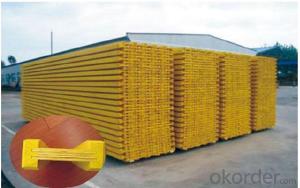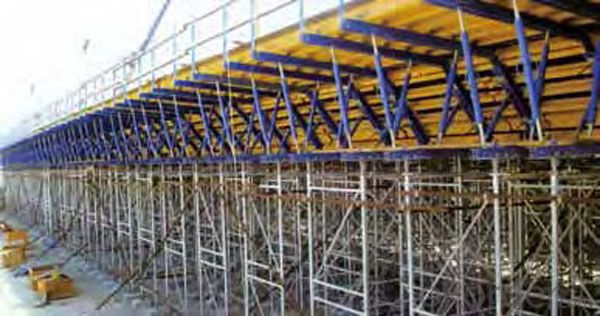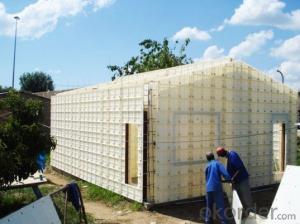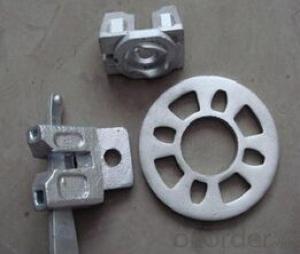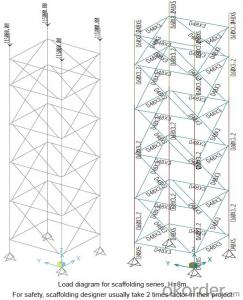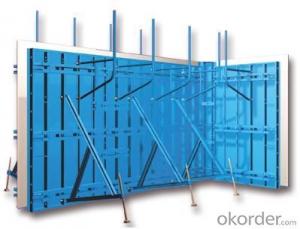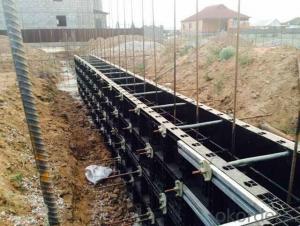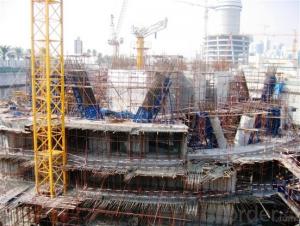Used Construction Scaffolding Formwork Ringlock Scaffolding Rosette for Wholesales
- Loading Port:
- Tianjin
- Payment Terms:
- TT OR LC
- Min Order Qty:
- 10000 set
- Supply Capability:
- 50000 set/month
OKorder Service Pledge
OKorder Financial Service
You Might Also Like
Used Construction Scaffolding Formwork Ringlock Scaffolding Rosette for Wholesales
Frame Scaffolding Systems Formwork Bs Standard Scaffolding Tube With Low Price
Developing with new technology materials, steel formworks is no longer a must in construction concrete process. More and more buildings are established with plastic formworks. And workers love this new formworks much more.
The advantages of plastic formworks:
1.First of all--light
Yes it is the first advantage of plastic formwork. It wins the great praise of both contractors and workers.
The biggest panel is 120×1500px,weights 10.5kg only. It can be lift and set up by one person easily, which means there is no need for cranes on site.Saves a lot of cost and time.
2.Easy set up
Different size of panels can firmly locked by simply turn the special handles to 90 degree. The Panels has rib on the back, which makes the system need not traditional wood blocks and nails. The panels have holes to fit tie rod, guarantee the strength of the whole system.
3.Modularity
Modular formworks composed by different size of panels,the main item is 120×1500px panel,which is used for the large area of walls and slabs. There are also small size of panels like 10×1500px,20×1500pxcm,25×1500px,inner corner 20×20×1500px and outer corner 10×5×1500px.Due to the variety of panel size, the system can form almost all size walls 120×1500px panel of multiply by 125px. The material of modular formwork is PC-ABS mixed with special glass fibers which enable panels to hold high pressures.
4.Strength
The handles are made by high strength Nilon, each panel locked by at least 4 handles, which makes the whole system strong enough to pour 1000px walls.
5.Environment friendly
The system needs no cut and nail due to the variety size. Also it needs nearly no wood. The material can be recycled after broken, so it will not pollute the environment.
6.Consequent
Concrete does not stick to plastic formwork, thus the panels need no oil before using, and can be cleaned simply by water. The surface of the wall which build by modular formwork is smooth and without rework.
Used Construction Scaffolding Formwork Ringlock Scaffolding Rosette for Wholesales
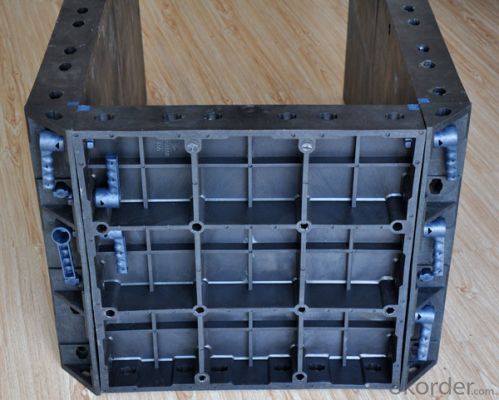
Used Construction Scaffolding Formwork Ringlock Scaffolding Rosette for Wholesales

Used Construction Scaffolding Formwork Ringlock Scaffolding Rosette for Wholesales
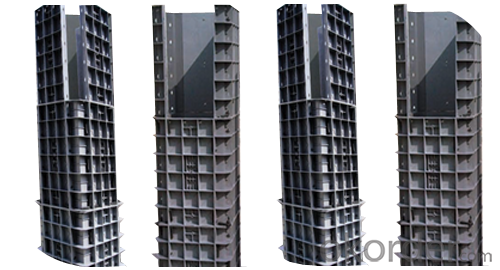
Advantage
* Good loading capacity
* Easy to assemble and dismantle
* Stable and durable thanks to its structual design & automatic welding quality
* Customized solution helps you work safe, save cost and convenient
* Excellent quality for formwork & scaffolding with wide choices
Used Construction Scaffolding Formwork Ringlock Scaffolding Rosette for Wholesales
Packing
in bulk or in bundle, or as requested
Shipping
15-20 Days.
Normally small orders, it needs just 15-20 business days to the port. For goods with stock, it would be even shoter.
Other scaffolding & formwork products:
(1) Scaffolding System:
Including Ringlock Scaffolding System and accessories; Cuplock Scaffolding System and accessories; Kwikstage Scaffolding System and accessories; Haki Scaffolding System and accessories;
(2) Scaffolding Frame & Accessories:
Including Walk Through Frame Scaffolding; Ladder Frame Scaffolding; Accessories; we also can make scaffolding according to your samples or drawings.
(3) Scaffolding Couplers/Clamps:
We can produce all kinds of forged and pressed couplers, including British type couplers, American type couplers, German type couplers, Italian type couplers ,fence couplers, BRC coplers and so on. We also can produce according to your drawings or samples.
(4) Formwork System Scaffolding & Accessories:
Light Duty Shoring prop and Heavy Duty Shoring Prop; Wing nuts and Tie rods; RASTO clamp and so on.
FAQ Used Construction Scaffolding Formwork Ringlock Scaffolding Rosette for Wholesales
Why Us?
We are one of the Top 500 in the world, largest construction materials supplier in China. Also we are a state-owned company and respond to every customer with large and also small orders.
We own professional manufacturers with powerful producing capacity.
Extensive and comprehensive quality control system
Excellent products with competitive prices.
Efficient services in pre and after sale.
Full energy with affluent experience team.
- Q: What are the different types of formwork release agents used with steel frame formwork?
- Different types of formwork release agents can be utilized with steel frame formwork to prevent concrete from adhering to the formwork. This allows for easy removal once the concrete has hardened. 1. Petroleum-based release agents are commonly employed and are composed of a mixture of petroleum oils and additives. These agents possess favorable release properties and are easily applied. They are suitable for use on both steel and wooden formwork. 2. Water-based release agents are made from a blend of water and surfactants. They are environmentally-friendly and have a low VOC content. These agents can be employed with steel formwork and provide a satisfactory release surface. 3. Silicone-based release agents are utilized when a higher level of release is necessary. They offer a superior surface finish and can be used with steel formwork. However, they tend to be more expensive compared to petroleum or water-based options. 4. Non-staining release agents are used when a clean and stain-free concrete surface is desired. These agents do not leave any residue on the concrete surface, ensuring a high-quality finish. They are commonly used in architectural applications where the appearance of the concrete is important. 5. Form release papers serve as an alternative to liquid release agents. They are thin, flexible sheets placed between the formwork and the concrete. Form release papers provide an effective release surface and can be used with steel formwork. They are user-friendly and eliminate the need for applying a liquid release agent. When selecting a formwork release agent for steel frame formwork, it is crucial to consider the specific project requirements. Factors such as desired finish, environmental concerns, and cost should be taken into account.
- Q: What are the different types of safety barriers and guardrails used with steel frame formwork?
- There are several types of safety barriers and guardrails commonly used with steel frame formwork, including: 1. Standard guardrails: These are horizontal barriers installed along the edge of the formwork platform to prevent accidental falls. They are typically made of steel or aluminum and are designed to withstand a specified amount of force. 2. Toe boards: Toe boards are installed along the bottom edge of the formwork platform to prevent items or debris from falling off the edge. They are usually made of wood or metal and provide an additional layer of safety. 3. Handrails: Handrails are vertical barriers installed along the edges of stairs, ramps, or other elevated areas to provide support and stability for workers. They are typically made of steel or aluminum and are designed to be grasped by hand. 4. Mesh barriers: Mesh barriers are installed along the sides of the formwork platform to prevent items from falling off. They are usually made of metal or plastic and feature small openings to allow visibility and airflow while maintaining safety. 5. Safety nets: Safety nets are installed below the formwork platform to catch falling objects or workers in the event of an accident. They are typically made of high-strength polypropylene or nylon and are capable of absorbing impact forces. These safety barriers and guardrails are essential components of a comprehensive safety plan when working with steel frame formwork, helping to protect workers from falls, prevent objects from falling, and ensure a secure working environment.
- Q: How does steel frame formwork handle the placement of embedded items and fixtures?
- Steel frame formwork is a versatile construction system that allows for easy handling and placement of embedded items and fixtures. Its modular design and adjustable features enable precise positioning of these elements within the concrete structure. The steel frames provide stability and support, ensuring that the embedded items and fixtures are securely held in place during the pouring and setting of the concrete. Additionally, the steel frame formwork allows for easy access and adjustments, making it convenient to install or modify embedded items and fixtures as per project requirements.
- Q: How does steel frame formwork prevent honeycombing or voids in concrete?
- Steel frame formwork prevents honeycombing or voids in concrete by providing a sturdy and rigid structure for the pouring and shaping of the concrete. When using steel frame formwork, the formwork is carefully designed and constructed to ensure that it holds the concrete in place and prevents any leakage or seepage. The steel frames are usually made from strong and durable materials, such as steel beams or panels, which can withstand the pressure and weight of the concrete. Additionally, steel frame formwork is usually lined with plywood or other formwork facing materials, which further help to create a smooth and even surface for the concrete. This lining also prevents any leakage or seepage of the concrete, ensuring that it fills all the desired spaces without creating any voids or honeycombing. Furthermore, the steel frame formwork system typically includes various types of ties or clamps, which are used to secure the formwork tightly together. This ensures that the formwork remains in its intended position during the concrete pouring and curing process, preventing any shifting or movement that could lead to honeycombing or voids. Overall, steel frame formwork provides a reliable and sturdy structure for pouring concrete, ensuring that it is contained and shaped properly. By eliminating any potential gaps or spaces, steel frame formwork helps to prevent honeycombing or voids in the final concrete structure, resulting in a stronger and more durable finished product.
- Q: How does steel frame formwork affect the overall aesthetics of a concrete finish?
- Steel frame formwork can significantly impact the overall aesthetics of a concrete finish. The use of steel frame formwork ensures superior quality and precision in the construction process, resulting in a smooth and flawless finish. The rigid steel frame acts as a support system, preventing any deformation or shifting during the pouring and curing stages of concrete. The steel frame formwork also provides a consistent and accurate formwork system, which allows for precise shaping and molding of the concrete structure. This enables architects and designers to achieve their desired aesthetic vision without any compromise. The straight lines, sharp edges, and smooth surfaces that can be achieved with steel frame formwork contribute to a visually appealing and modern appearance. Furthermore, steel frame formwork offers versatility and adaptability in design. It can be easily adjusted and customized to meet specific architectural requirements and desired finishes. Whether it is creating unique patterns, textures, or intricate designs, steel frame formwork provides the necessary flexibility to achieve the desired aesthetic outcome. In addition to aesthetics, steel frame formwork also enhances the durability and longevity of the concrete finish. The use of steel ensures structural integrity and strength, preventing any potential damage or deterioration over time. This means that the concrete finish will maintain its aesthetic appeal for a longer period, reducing the need for frequent maintenance or repairs. Overall, steel frame formwork plays a crucial role in shaping and enhancing the aesthetics of a concrete finish. It provides a solid foundation, precision, and versatility, allowing for the creation of visually pleasing and durable architectural designs.
- Q: Does steel frame formwork require any special maintenance?
- Yes, steel frame formwork does require some special maintenance. Firstly, after each use, the formwork needs to be properly cleaned to remove any concrete residue or debris that may have accumulated. This can be done using high-pressure water or wire brushes. Additionally, any rust or corrosion that may have developed on the steel frame should be treated and removed to prevent further damage. It is also important to regularly inspect the formwork for any signs of wear and tear, such as cracks, dents, or bent components. Any damaged parts should be repaired or replaced to ensure the formwork's structural integrity and safety. Furthermore, proper storage is crucial to maintaining the quality and longevity of steel frame formwork. The formwork should be stored in a dry and well-ventilated area to prevent moisture buildup and corrosion. It is also advisable to coat the steel frame with a rust-resistant paint or protective coating to provide an additional layer of protection against environmental factors. Regular maintenance and upkeep of steel frame formwork will not only extend its lifespan but also ensure its reliability and safety during construction projects.
- Q: How does steel frame formwork prevent the formation of air voids or honeycombs in the concrete?
- By providing a rigid structure, steel frame formwork prevents the formation of air voids or honeycombs in concrete during pouring and curing. Acting as a mold or template, the steel frame ensures proper pouring and compaction. The formwork is designed with tight joints and seals to prevent concrete leakage, ensuring complete filling of voids and corners. Furthermore, the steel frame offers support and stability, preventing movement and shifting that could create gaps or voids. Inspection and monitoring of concrete placement are made easy with the steel frame formwork, ensuring even distribution and compaction. Ultimately, the use of this formwork method effectively prevents the formation of air voids or honeycombs, resulting in a high-quality and durable end product.
- Q: What are the different types of formwork wedges used with steel frame formwork?
- Some of the different types of formwork wedges used with steel frame formwork include flat wedges, wedge bolts, and snap ties. These wedges are used to secure the formwork panels together and provide stability during the concrete pouring process.
- Q: Are there any restrictions on the concrete mix design that can be used with steel frame formwork?
- Restrictions exist regarding the concrete mix design that can be utilized with steel frame formwork. Steel frame formwork is a formwork system designed to support the weight of the concrete during pouring and curing. It is composed of assembled steel frames that create a mold for the concrete. One of the primary restrictions concerns the workability of the concrete mix. The concrete mix employed with steel frame formwork must possess a specific level of workability, ensuring easy pouring into the formwork and proper compaction. If the concrete mix is excessively stiff or fluid, issues like inadequate compaction, segregation, or excessive bleeding may arise. These problems can compromise the quality and strength of the final concrete structure. Another restriction concerns the strength of the concrete mix. The concrete used with steel frame formwork must possess sufficient strength to support the weight of the formwork and the concrete itself without deformation or failure. The strength of the concrete is determined by the mix design, which includes the proportions of cement, aggregates, water, and any admixtures. The mix design should be carefully selected to achieve the desired strength and durability of the concrete. Considering the curing requirements of the concrete mix is also crucial. After pouring, proper curing is necessary to achieve the concrete's full strength and durability. Steel frame formwork can influence the curing process by providing some insulation, which affects the rate of hydration and strength development in the concrete. Consequently, the concrete mix should be designed to accommodate the curing conditions associated with steel frame formwork. Additionally, certain admixtures or additives may not be compatible with steel frame formwork. For instance, some admixtures that accelerate or retard the concrete's setting time can interfere with the formwork's proper installation and removal. It is important to assess the compatibility of admixtures with steel frame formwork and consult experts or manufacturers to ensure the suitability of the concrete mix for this type of formwork. In conclusion, while there are restrictions on the concrete mix design for steel frame formwork, it is possible to design a mix that meets these requirements. Factors such as workability, strength, curing requirements, and admixture compatibility must be carefully considered to ensure the successful and efficient use of steel frame formwork in concrete construction projects.
- Q: What are the different types of formwork joints used with steel frame formwork?
- There are several types of formwork joints that can be used with steel frame formwork. These joints are designed to ensure the stability and strength of the formwork system during the concrete pouring process. Some of the different types of formwork joints commonly used with steel frame formwork include: 1. Butt Joint: This is the simplest form of joint where two formwork panels are joined together end to end. It is typically used for straight walls or columns. 2. Corner Joint: This joint is used to connect two formwork panels at a corner. It provides stability and helps maintain the desired shape of the structure. 3. T-Joint: As the name suggests, this joint forms a T-shape where three formwork panels meet. It is commonly used for connecting walls that intersect at right angles. 4. L-Joint: Similar to the T-joint, the L-joint is used to connect two formwork panels at a 90-degree angle, forming an L-shape. It is typically used for forming walls or columns. 5. Y-Joint: This joint is used for forming walls or columns that branch out, creating a Y-shape. It provides stability and ensures that the concrete is properly contained. 6. Slip Joint: A slip joint is used to allow for movement between formwork panels. It is typically used in situations where thermal expansion or contraction may occur. 7. Key Joint: This joint is used to create a keyway in the concrete, which helps to transfer loads between adjacent pours. It is commonly used in large-scale projects where multiple pours are required. Each of these formwork joints serves a specific purpose and is used based on the requirements of the structure being constructed. The proper installation and use of these joints are crucial for ensuring the stability and integrity of the formwork system and the resulting concrete structure.
Send your message to us
Used Construction Scaffolding Formwork Ringlock Scaffolding Rosette for Wholesales
- Loading Port:
- Tianjin
- Payment Terms:
- TT OR LC
- Min Order Qty:
- 10000 set
- Supply Capability:
- 50000 set/month
OKorder Service Pledge
OKorder Financial Service
Similar products
Hot products
Hot Searches
